ACC GEOMETRY MIDTERM VOCAB
1/79
There's no tags or description
Looks like no tags are added yet.
Name | Mastery | Learn | Test | Matching | Spaced |
|---|
No study sessions yet.
80 Terms
slope formula
slope intercept formula
y=mx+b
point slope formula
y-y₁=m(x-x₁)
standard form (+ rules)
Ax + By = C
*A, B, C cannot be fractions
*A cannot be negative
parallel lines
coplanar lines that do not intersect
same slope
different y-intercept
lines never touch
symbol → | |
perpendicular lines
2 lines that intersect to form right angles (always coplanar)
slopes are opposite signs and reciprocals
y-intercept can be same or different
symbol → ⊥
horizontal lines have slopes that are…
ZERO
always written as y = #
where line crosses the y-axis
vertical lines have slopes that are…
UNDEFINED
always written as x = #
where line crosses x-axis
points
most basic building block of geometry
no size, height, depth; only location (can be on a line, plane, or within space)
represented with a dot
named with a Capital letter
lines
straight, continuous, infinitely many points
infinite length in 2 directions, but no thickness
represented by a line with arrows on the end
named by placing a line symbol above the letters of 2 points on the line OR by a single, lowercase script letter
planes
have only length and width, but no thickness
can be described as a flat surface that extends infinitely along its length and width
represented with a 4-sided figure that resembles a tilted piece of paper
BUT REMEMBER…INFINITE!
named by using the word “plane” and 3 points on the plane (or a single script uppercase letter)
how many points “determine” a line?
2 DISTINCT points determine a line
how many points “determine” a plane?
3 DISTINCT NONCOLLINEAR points determine a plane
any 3 points are coplanar but not any 3 points determine a plane
a minimum of 3 points determine a plane, but 1 point MUST be collinear
collinear vs. non-collinear
on the same line
non: not on the same line
ANY TWO POINTS ARE COLLINEAR
coplanar vs. non-coplanar
on the same plane
non: NOT on the same plane
ANY 3 POINTS ARE COPLANAR
line segment
2 points called the ENDPOINTS of the segment and all the points between them that are collinear with the two points
can be MEASURED.
To denote: do not include the bar over the letters or use “m” for “measure” in front of the segment name.
rays
part of a line that begins at a point and extends infinitely in one direction
The 1st letter is the endpoint of the ray and the 2nd is any other point that the ray passes through
congruence
2 segments that have the same measure or length
symbol → ≅
congruent vs equal
congruent:
when using segment symbol (AB ≅ CD)
pretend there is a segment symbol over it
equals:
no segment symbol (CP = AL)
numbers/measures (AL = 7 cm)
addition, subtraction, multiplication, division (CP + AL = CL)
midpoint
the point on a segment that is the same distance from both endpoints
bisect
divide into 2 congruent parts
the midpoint bisects the segment
space
the set of all points
what determines space? 4 DISTINCT COPLANAR points
skew lines
non-coplanar lines that do not intersect
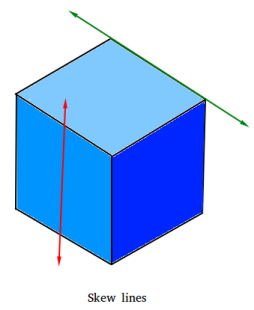
not contained (through) vs contains
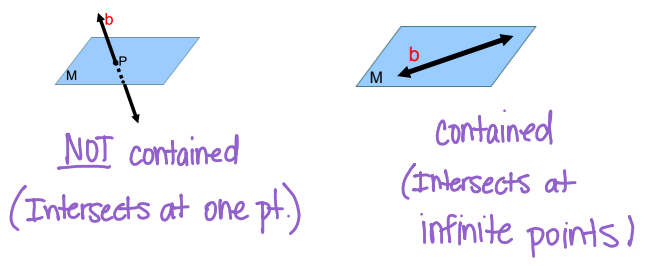
intersections
2 distinct lines intersect at a point
a plane and aline not contained in the plane intersect at a point
2 distinct planes intersect at a line
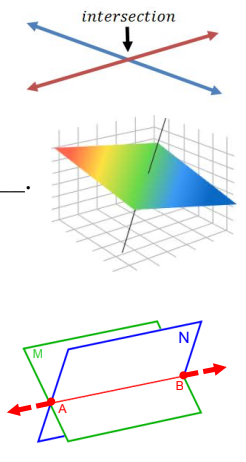
intersections (pt 2)
3 distinct planes can intersect at a line or a point
or no common point(s) of intersection
a line and a plane intersect at a point or infinite points
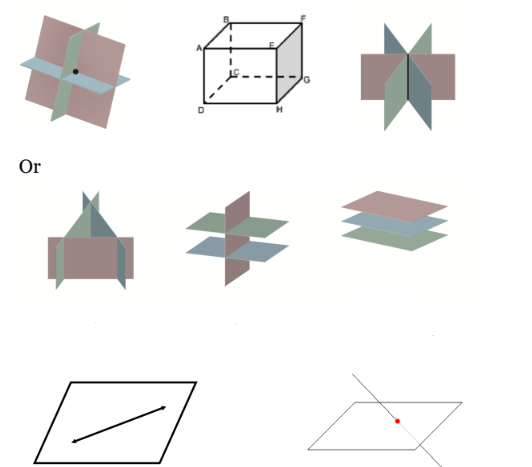
angle
formed by 2 rays that share a common endpoint
the common endpoint = VERTEX
the 2 rays = SIDES
symbol → ∠
naming angles (3 ways)
1) use 2 capital letters. VERTEX MUST BE MIDDLE LETTER (<TAP)
2) IFF (if and only if) an angle is alone, you may name it by its vertex only. (<A)
3) you can name an angle with a number if the angle is labeled with one (<1)
measure of an angle
measure of an angle is the smallest amount of rotation about the vertex from one ray to the other
angles are measured in degrees
to indicate the measure of <A we write m<A (m<A = 65 degrees)
reflex angle
the other “larger angle” with the same sides and vertex
to find the reflex angle, we always subtract from 360 degrees
congruent angles + congruency statement + equality statement
congruent angles = angles with the same measure
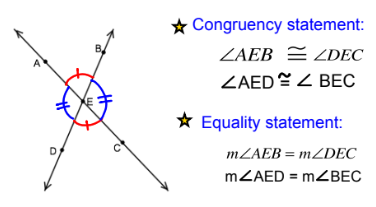
adjacent angles
2 coplanar
non-overlapping
common vertex
one common side (next to each other)
angle bisector
a ray, line, or line segment that contains a vertex and divides an angle into 2 congruent angles.
if two triangles are similar then the lengths of corresponding angle bisectors are proportional to the lengths of corresponding sides

conditional statements
If - then statements
Usually written in two parts
Hypothesis: The part of the statement that is known to be true/ the part after the if
Conclusion: The part of the statement that can be concluded
Converse
a statement that reverses the hypothesis and conclusion
Not always true
biconditional statements
combine original statement and the converse if they are both true
Definitions are always biconditionals
Can be written in reverse order
Uses IFF (if and only if)
right angle
measures exactly 90 degrees
acute angle
measures less than 90 degrees but more than 0
obtuse angle
measures more than 90 degrees but less than 180 degrees
complementary angles
a pair of angles whose measures have a sum of 90 degrees
do not have to be adjacent
supplementary angles
a pair of angles whose measures have a sum of 180 degrees
do not have to be adjacent
vertical angles
angles formed by 2 intersecting lines that share a common vertex but not side
linear pair of angles
2 angles are a linear pair if they share a vertex and a common side and their noncommon sides form a line (adjacent angles that are supplementary)
straight angle
an angle whose measure is exactly 180 degrees/a straight line
3rd side rule
The length of any side of a triangle must be greater than the difference of the other 2 sides and less than the sum of the other 2 sides (when asked to list all sides: difference < 3rd side< sum)
3rd angle rule
If two angles are congruent the third angle is also congruent
contained vs. not contained
contained: line intersects at infinite points
not contained: line intersects the plane at one point
midpoint formula

transversal
a line intersecting two or more other lines in a plane (red line in example)
corresponding angles
angles formed in corresponding positions (always on the same side of the transversal)
alternate interior/exterior angles
on alternate sides of the transversal on the interior/exterior of the 2 lines
same-side interior/exterior angles
same side of the transversal and on the interior/exterior of the two lines
scalene triangle
has all different side measurements
equilateral triangle
has all the same side measurements
isosceles triangle
has at least 2 sides of the same length (all equilateral triangles are isosceles)
altitude
a segment from a vertex of a triangle perpendicular to the opposite side (or the line containing the opposite side)
if two triangles are similar then the lengths of corresponding altitudes are proportional to the lengths of corresponding sides
median
a segment from the vertex of a triangle to the midpoint of the opposite side
if two triangles are similar then the lengths of the corresponding medians are proportional to the lengths of the corresponding sides
concurrent lines
a set of 3 or more coplanar lines that intersect at a point
POINT OF CONCURRENCY: where concurrent lines meet.png)
centroid
a point of concurrency where the 3 medians intersect
divides each median into 2 parts so that the distance from the centroid to the vertex is twice the distance from the centroid to the midpoint of the opposite side
center of gravity

congruent triangles
triangles that have the same size and shape.
2 triangles are congruent if and only if all 3 pairs of corresponding angles and sides are congruent
similar figures
2 polygons are similar if their vertices can be paired so that'
the corresponding angles are congruent
the corresponding sides are all in the same proportion/ratio
similarity ratio + area ratio + volume ratio

geometric mean
2 numbers are across from each other in a ratio
in a geometric mean problem, the means are always the same values

altitude rule
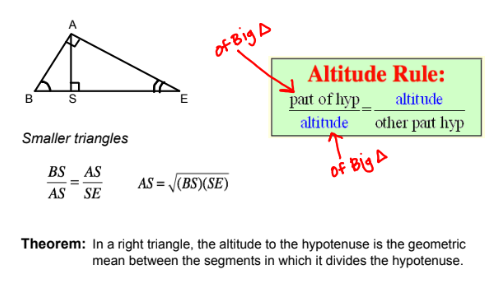
leg rule
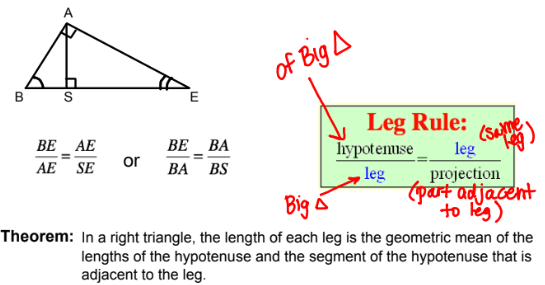
translation
slides an object a fixed distance in a given direction
Original shape and translation have the same shape and size (are congruent)
Rigid transformation
Facing same direction/orientation
Points that are collinear stay collinear
Lines that are parallel in original are parallel in translation
Midpoints of shape’s segments stay intact
notation/rule for translations
<a,b>
(x,y) → (x+a, y+b)
T(a,b)
reflections
creates a congruent figure
Isometric transformation (transformation that preserves length)
Reflection is called a non-direct or opposite isometry
Preserves:
Distance
Angle measures
Parallelism
Collinearity
Midpoint
reflection over x-axis
(x, -y)
reflection over y-axis
(-x, y)
reflection over y = x
(y, x)
reflection over y = -x
(-y, -x)
rotation
a transformation in which a figure is rotated about a fixed point
Center of rotation: the fixed point that the figure is rotated about
rotation 90 clockwise/270 counterclockwise
(y, -x)
rotation 180 clockwise/counterclockwise
(-x, -y)
rotation 90 counterclockwise/270 clockwise
(-y, x)
dilation
transformation that creates a similar figure
Center of dilation: fixed point which terminates where the dilation is
K = scale factor or the ratio of the side length of the image to the corresponding side length of the pre-image
Dilation is a reduction if 0<k<1
Dilation is a enlargement if k>1
dilation rule
(kx, ky)
composition
when two or more transformations are combined to form a new transformation
glide reflection
a transformation consisting of a translation combined with a reflection
Preserves:
Distance
Angle measures
Parallelism
Collinearity
Midpoint